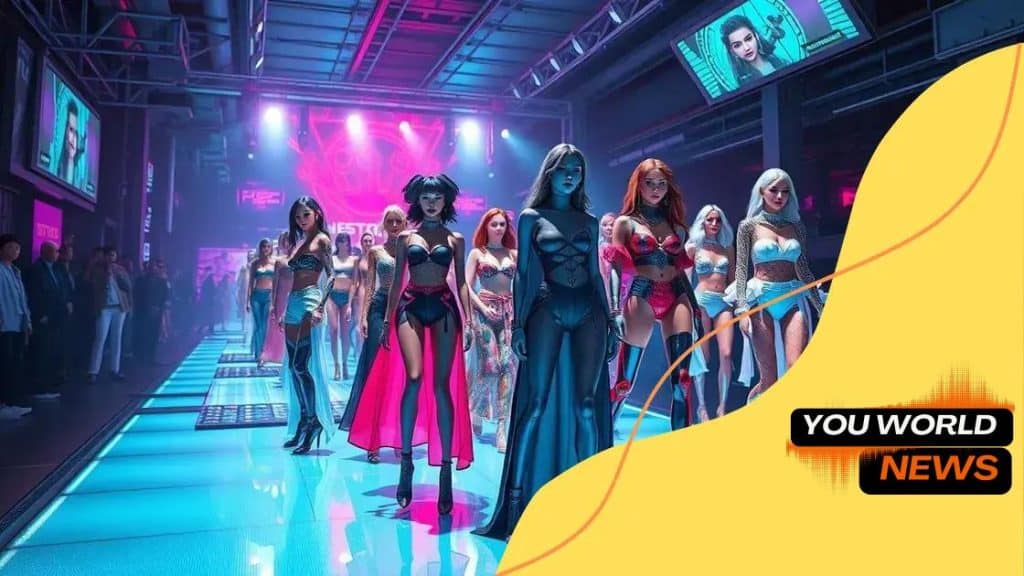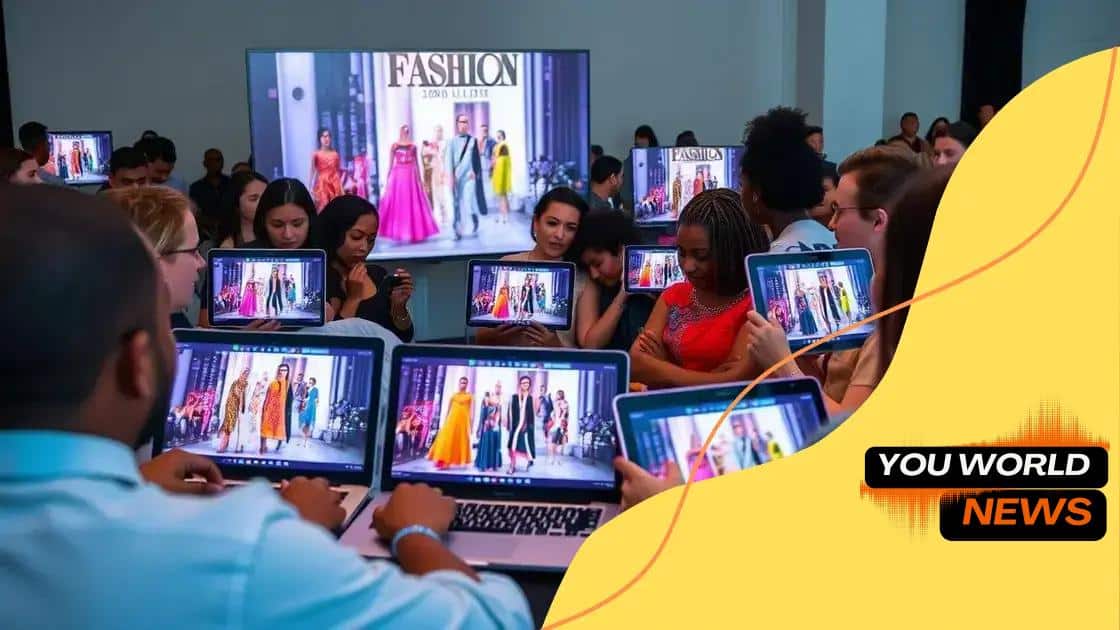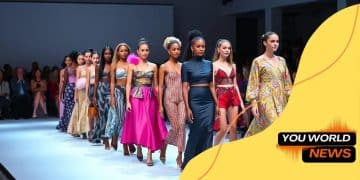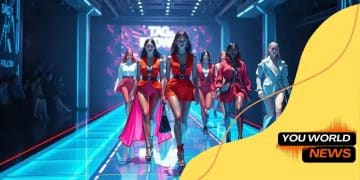Virtual fashion shows: the new runway era begins

Virtual fashion shows revolutionize the industry by increasing global accessibility, integrating advanced technologies like AR and VR, and promoting sustainability through digital presentations, reshaping how designers connect with audiences.
Virtual fashion shows: The new runway era are changing how we perceive fashion and its presentation. Have you ever imagined experiencing a runway from the comfort of your home? In this article, we’ll dive into this fascinating shift in the fashion landscape.
The rise of virtual fashion shows
The rise of virtual fashion shows has taken the fashion industry by storm. This innovative format has made it easier for designers to showcase their collections to a global audience, breaking down geographical barriers. In the past, attending a fashion show often meant being in the right place at the right time, but now, technology has enabled anyone to experience the thrill of a runway show from home.
Key Factors Driving This Change
Several factors contribute to the growing popularity of virtual fashion shows. These events have become essential for many designers, especially during challenging times when in-person gatherings are limited. Here are a few key elements:
- Accessibility: Virtual shows allow a wider audience to experience fashion, regardless of location.
- Cost-effectiveness: Hosting a virtual event can often be less expensive than traditional shows.
- Innovative technologies: Designers can utilize augmented reality, interactive elements, and other cutting-edge technologies to enhance the viewer experience.
Moreover, brands can collect valuable data on viewer engagement, helping them tailor future collections and marketing strategies. Virtual fashion shows also enable more creativity, as designers can experiment with stunning visuals and storytelling that might not be possible on a physical runway.
The Impact on Audience Engagement
With the shift to virtual platforms, audiences are no longer just passive watchers but can engage actively through social media and interactive features. This engagement allows fans to connect with their favorite brands and designers in meaningful ways, fostering a sense of community. Virtual reality can further immerse viewers in the experience, making them feel a part of the action.
As we embrace this new era, the future looks bright for virtual fashion shows. Designers can reach new demographics, and audiences enjoy unprecedented access to the creativity of the fashion world.
Benefits of virtual fashion for designers
The benefits of virtual fashion for designers are numerous and impactful. This format allows designers to expand their reach, showcase their creativity, and adapt to changing market demands. By utilizing virtual platforms, they can connect with audiences globally, eliminating the need for expensive venues and logistics.
Cost Efficiency
One major advantage of virtual fashion shows is cost efficiency. Traditional shows require significant investments in models, locations, and production. In contrast, virtual events can cut costs dramatically, allowing designers to allocate resources to innovative designs and marketing.
- Reduced overhead: Less expense on stages and travel.
- Creative freedom: More budget can be used on artistry and technology.
- Global exposure: Ability to reach more viewers without geographical limits.
This financial flexibility can lead to bolder and more experimental collections as designers feel less constrained by traditional norms.
Enhanced Creative Opportunities
Virtual shows provide unique creative opportunities that are often not possible in physical settings. Designers can incorporate augmented reality, allowing viewers to interact with garments virtually. This level of innovation can heighten the emotional connection between the audience and the designs.
Additionally, with virtual platforms, designers can showcase their work in diverse environments, using captivating digital backgrounds and effects that enhance storytelling. This creativity not only entertains but also engages audiences on a deeper level.
Furthermore, virtual fashion shows enable designers to achieve greater flexibility in presentation. They can easily modify their shows based on real-time feedback and analytics, ensuring that the audience remains engaged and invested in their work.
How virtual shows increase accessibility

Understanding how virtual shows increase accessibility is crucial in today’s fashion landscape. With virtual platforms, more audiences can engage with collections, no matter where they are located. This transformation allows fashion enthusiasts to experience shows that were once exclusive to a select few.
Global Reach
One of the most impactful aspects of virtual fashion shows is their ability to reach a global audience. Traditional fashion events often limited attendance to those in specific cities or countries. Now, anyone with an internet connection can join these shows, broadening the viewer base tremendously.
- Diverse audience: Viewers from different backgrounds can participate.
- Increased engagement: More people can interact and connect with brands.
- Opportunity for feedback: Designers can hear from a larger variety of audiences.
By connecting with a wider range of viewers, designers can also incorporate diverse perspectives into their work, reflecting a more global culture in fashion.
Eliminating Physical Barriers
Virtual shows eliminate many physical barriers that often restricted attendance. Individuals who may have faced challenges, such as travel constraints, physical disabilities, or financial hurdles, can now participate without limitations. This shift promotes inclusivity, ensuring that fashion is accessible to everyone.
The ability to experience fashion in a safe environment also allows viewers to explore their interests without pressure. This freedom fosters a sense of community among fashion lovers globally. Furthermore, brands can use augmented reality to showcase clothing, allowing viewers to see how items move and fit, enhancing their shopping experience.
Impact on traditional fashion industry
The impact on the traditional fashion industry from virtual fashion shows is profound and transformative. As designers embrace this new format, they challenge established norms and alter the way fashion is marketed and consumed.
Changing Consumer Behavior
With the rise of virtual fashion shows, consumer behavior is shifting rapidly. Viewers are no longer just passive spectators. They actively interact with brands through social media and other platforms. This engagement creates a dialogue between consumers and designers, which can shape future collections.
- Feedback loops: Brands can gather real-time feedback on designs.
- Personalization: Consumers desire tailored experiences that reflect their preferences.
- Instant accessibility: Viewers can purchase items right after the show.
This immediacy and personalization have led to increased sales as fans can access collections from anywhere in the world, making fashion more reactive to current trends and tastes.
Challenges for Traditional Formats
While virtual shows bring many benefits, they also introduce challenges for the traditional fashion industry. Physical runway shows have long been synonymous with prestige, but as virtual formats rise, some may question the exclusivity and allure of in-person events.
Brands must now find ways to blend the unique aspects of traditional presentations with the advantages of virtual shows. This includes creating immersive experiences that evoke the excitement of in-person events while maintaining the accessibility offered by virtual formats.
The competition is also fierce as more designers enter the virtual space. Established brands must innovate constantly to keep their audiences engaged. As a result, the traditional fashion industry is evolving, pushing designers toward more creativity and collaboration.
Future trends in virtual fashion events
The future trends in virtual fashion events indicate a dynamic shift that will reshape how fashion is presented and experienced. As technology continues to advance, we can expect a wave of innovative ideas that enhance viewer engagement and accessibility.
Increased Use of Augmented and Virtual Reality
One significant trend is the integration of augmented reality (AR) and virtual reality (VR) into fashion shows. These technologies allow viewers to immerse themselves in the presentations. With AR, audiences can visualize how clothing looks on them without trying anything on.
- Interactive experiences: Viewers can engage with models and garments virtually.
- Enhanced storytelling: Brands can showcase not just clothes but the concepts behind them.
- 3D modeling: Designs can be viewed from various angles, offering a comprehensive perspective.
This transformation not only entertains but also helps consumers make informed purchasing decisions.
Sustainability and Ethical Practices
As the fashion world becomes more conscious of its environmental impact, sustainability will play a crucial role in future virtual events. Designers will highlight eco-friendly practices through online platforms. They may focus on:
- Virtual showrooms: Reducing waste by eliminating physical samples.
- Transparency: Sharing the origin of materials used in collections.
- Community engagement: Involving consumers in sustainable initiatives.
This trend will appeal to consumers who prioritize ethical brands, further promoting responsible fashion practices.
Moreover, the move to virtual platforms allows brands to respond swiftly to changing market trends. As consumers become more environmentally aware, designers will adapt their approaches to align with these values. The fusion of technology, creativity, and sustainability will define the future of virtual fashion events.
The future of virtual fashion events is bright and filled with exciting possibilities. As we move forward, we can expect to see more innovative uses of technology, enhanced viewer experiences, and a stronger focus on sustainability. The fashion industry is evolving, and virtual shows are becoming integral to this transformation. By embracing change, designers and brands can create more inclusive and captivating experiences for everyone.
Here’s a brief summary of the key points:
FAQ – Frequently Asked Questions about Virtual Fashion Shows
How do virtual fashion shows increase accessibility?
Virtual fashion shows allow anyone with an internet connection to view collections, breaking down geographic barriers and making fashion more inclusive.
What technologies are used in future virtual fashion events?
Augmented reality (AR) and virtual reality (VR) will be integrated into virtual shows to enhance viewer experiences and interactivity.
How are brands focusing on sustainability in virtual fashion?
Brands are highlighting eco-friendly practices, reducing waste by presenting collections digitally, and using sustainable materials in their designs.
What impact do virtual shows have on traditional fashion events?
Virtual shows challenge the exclusivity of traditional events, pushing brands to innovate and adapt to changing consumer demands and expectations.





